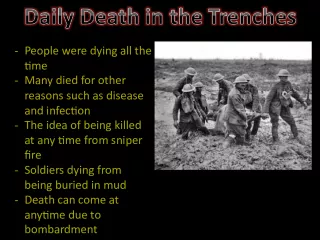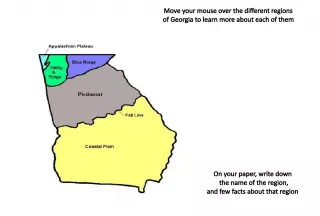The Battle of Vimy Ridge: Key Facts
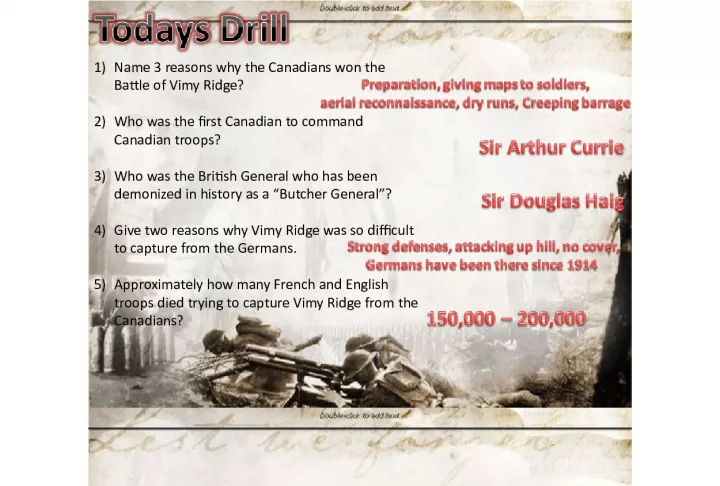

Learn about the Canadian victory at Vimy Ridge, the first Canadian to command troops, the "Butcher" General, and the challenges of capturing the ridge. Discover why the Canadians' efforts were crucial in closing a significant gap in the Allied line.
- Uploaded on | 2 Views
-
 brielle
brielle
About The Battle of Vimy Ridge: Key Facts
PowerPoint presentation about 'The Battle of Vimy Ridge: Key Facts'. This presentation describes the topic on Learn about the Canadian victory at Vimy Ridge, the first Canadian to command troops, the "Butcher" General, and the challenges of capturing the ridge. Discover why the Canadians' efforts were crucial in closing a significant gap in the Allied line.. The key topics included in this slideshow are . Download this presentation absolutely free.
Presentation Transcript
Slide11)Name 3 reasons why the Canadians won the Battle of Vimy Ridge? 2) Who was the first Canadian to command Canadian troops? 3) Who was the British General who has been demonized in history as a “Butcher General”? 4) Give two reasons why Vimy Ridge was so difficult to capture from the Germans. 5) Approximately how many French and English troops died trying to capture Vimy Ridge from the Canadians?
Slide4- the 1st canadian division arrived at the front which was located just outside the city of Ypres, in Belgium. - The German army fired 5,700 rounds of chlorine gas filled rounds on to Canadian and Allied positions - During the gas attack, the allied French Army was forced to retreat leaving a four- mile gap in the Allied line. - The Canadians knew that the gap was a very big disadvantage, so they spent the whole night attempting to fill it.
Slide5-The only protection Canadian soldiers had against the gas attack was to wrap their mouths in damp cloth to filter out some of the gas (usually they used urine to dampen the cloth). - The Canadians withdrew from the battle on May 3rd, where they were relieved by British forces. - The number of Canadian casualties accounted for were 5975, and 1000 of these were termed fatal. - Losses during the Second Battle of Ypres are estimated at 69,000 Allied troops (59,000 British, 10,000 French), against 35,000 German. - After the battle of Ypres, Canada sat in a different position in the eyes of Belgium and France. The name Canada was a word symbolizing thankfulness and bravery due to the effort of the 1st division in the battle of Ypres.
Slide6 “german gas is heavier than air and soon fills the trenches and dugouts, where it hasbeen known to lurk for two or three days, until the air is purified by means of large chemical sprayers. We had to work quickly, as Fritz generally follows the gas with an infantry attack. A company man on our right was too slow in getting on his helmet; he sank to the ground, clutching at his throat, and after a few spasmodic twistings, went West (died). It was horrible to see him die, but we were powerless to help him. In the corner of a traverse, a little, muddy cur dog, one of the company's pets, was lying dead, with his two paws over his nose. It's the animals that suffer the most, the horses, mules, cattle, dogs, cats, and rats, they having no helmets to save them. Tommy does not sympathize with rats in a gas attack.” - Arthur Guy Empey, Over The Top (1917)
Slide8-The French Commander in Chief, Joseph Joffre, conceived the idea as a battle of attrition, the aim being to drain the German forces of reserves, although territorial gain was a secondary aim. This was agreed upon by British High Commander Sir Douglas Haig. - The attack was preceded by an eight-day preliminary bombardment of the German lines, beginning on Saturday 24 June. This was meant to destroy the entanglement of barbed wire and destroy much of the German defenses - The artillery bombardment failed to destroy either the German front line barbed wire or the heavily-built concrete bunkers. Also, much of the munitions used by the British proved to be 'duds' - badly constructed and ineffective. - Many troops were killed or wounded the moment they stepped out of the front lines into No Man's Land. Despite heavy losses during the first day - 58,000 British troops alone - Haig persisted with the offensive in the following months.
Slide9-The first tanks, which totalled 50, reached the Somme in September. While they achieved a large measure of shocked surprise when sprung upon the German opposition, these early tanks proved clumsy and were highly unreliable. - More than 24,000 Canadians and 700 Newfoundlanders were killed, wounded or went missing in the Somme Region in 1916. - During the attack the British and French had gained 12 kilometres of ground, the taking of which resulted in 420,000 estimated British casualties, plus a further 200,000 French casualties. German casualties were estimated to be around 500,000. - Sir Douglas Haig's conduct of the battle caused - and still causes - great controversy. Critics argued that his inflexible approach merely repeated flawed tactics; others argue that Haig's hand was forced in that the Somme offensive was necessary in order to relieve the French at Verdun.
Slide10“what if our artillery had failed to cut "his" wire? Were his machine-gunners waiting to mow usdown as we struggled to break a way through his entanglements? The monotonous hammering of these questions must have had different effects on different men… A noise like the crisp crackle of twigs and branches, burning in a bonfire just beyond my vision in the mist, made me think I must be approaching some burning building. I realized, when my neighbour on the right dropped with a bullet in the abdomen, that the noise was machine-gun and rifle-fire…” - Private Fred Ball, Everyman at War (1930),
Slide11I have a rendezvous with DeathAt some disputed barricade, When Spring comes back with rustling shade And apple-blossoms fill the air-- I have a rendezvous with Death When Spring brings back blue days and fair. "June 28, 1916. We go up to the attack tomorrow. This will probably be the biggest thing yet. We are to have the honor of marching in the first wave. I will write you soon if I get through all right. If not, my only earthly care is for my poems. I am glad to be going in first wave. If you are in this thing at all it is best to be in to the limit. And this is the supreme experience."
Slide12"it was canada from the atlantic to the pacific on parade. I thought then. . . that in those few minutes I witnessed the birth of a nation.“ - Brigadier-General Alexander Ross
Slide13-Some 12km northeast of Arras Vimy Ridge gained early importance during the war on account of the heights which overlooked the Allied-held town. - German forces seized control of the ridge in September 1914 and promptly constructed deep defensive positions comprising bunkers, caves, passages and artillery-proof trenches, heavily protected by concrete machine gun emplacements. - With such formidable defensive precautions in place the German army rapidly set about the steady destruction of Arras, pounding the town with heavy artillery - apparently with impunity. - French attempts to grab control of the ridge throughout 1915 were bloodily repulsed with the loss of some 150,000 French casualties. The British had also attempted to take the ridge and failed.
Slide14-Since capturing the Ridge in October 1914, the Germans had been building fortifications to add to its natural strength and dominance. - The slopes of Vimy Ridge favoured the defenders: - Canadians would have to attack over open ground, where they would be prime targets for artillery, machine-gun and rifle fire. - They would face a maze of trenches, concrete machine-gun strong points with hedges of barbed wire woven around them, and deep dug-outs, all linked by communication trenches and connecting tunnels. - As well, there were vast underground chambers, some capable of sheltering entire German battalions from Allied shells.
Slide15-As the Canadian Commander of the 1st Division, Major-General Arthur Currie, said, "Take time to train them.” This is exactly what the Canadian Corps did. - A full-scale replica of the battle area was laid out with reams of coloured tape and flags behind the Canadian lines. - Here Canadian units carried out repeated exercises, rehearsing exactly what they would do throughout the day of the attack. - Maps were given out to guide the smallest units. The troops were fully informed about their objectives and their routes. Ariel reconnaissance and night raids helped the Canadians know more about German defenses - A series of tunnels and subways were tunnelled under ground before the battle. These tunnels were used to create underground explosions to destroy the German trenches, and communication and access tunnels to bring reserves to the front lines.
Slide16-At 5.30 a.m., April 9, 1917, Easter Monday, the creeping artillery barrage began to move steadily toward the Germans. - Behind it advanced 20,000 soldiers of the first attacking wave of the four Canadian divisions. - Within thirty minutes the Canadian 1st Division had succeeded in capturing German front line positions in spite of a snowstorm; within the next half hour, the second line had similarly passed into Canadian hands. - With the entire ridge wholly under Allied control by 12 April the operation was judged a spectacular success, the single most successful Allied advance on the Western Front to that date. The ridge remained in Allied hands for the remainder of the war.
Slide18-10,602 Canadians were wounded during the attack, and 3,598 killed. The opposing German force suffered even more heavily: 20,000 casualties. - Julian Byng later served as Canadian Governor- General, and Arthur Currie was knighted for his wartime services. Four Victoria Crosses were awarded as a consequence of fighting at Vimy Ridge: to Private William Milne, Lance-Sergeant Ellis Sifton, Captain Thaine MacDowell and Private John Pattison. - Vimy Ridge is seen as the battle which unified Canada and gave many Canadians a sense of international pride, at a level which had never been seen in Canadian history.
Slide19 “this morning the scene was changed as by a miracle. Snow was falling, blown gustilyacross the battlefields and powdering the capes and helmets of our men as they rode or marched forward to the front. But presently sunlight broke through the storm-clouds and flooded all the countryside by Neuville-St. Vaast and Thelus and La Folie Farm up to the crest of the ridge where the Canadians had just fought their way with such high valour… It was astounding to think that not a single German stayed up there out of all the thousands who had held it yesterday, unless some poor wounded devils still cower in the great tunnels which pierce the hillside.” - British war journalist Philip Gibbs
Slide21-Whereas the first and second battles of Ypres were launched by the Germans, the Third Battle of Ypres was intended as Sir Douglas Haig's Allied forces breakthrough in Flanders in 1917. - The aim of the campaign was to be the destruction of German submarine bases on the Belgian coast. The current level of shipping losses would prevent the British from sustaining the war into 1918, thus requiring clearance of the bases on the Belgian coast. - Haig, while recognising the urgency of this aim, was at least as interested in finally breaking the will of the German army, which he believed was near to collapse
Slide22-Canadian commander Arthur Currie inspected the battlefield and was shocked at the conditions. He tried to avoid having his men fight there but was overruled. - Early in October, the Canadians were sent to relieve the battered ANZAC (Australian and New Zealand Forces) forces and take part in the push to capture Passchendaele. on October 26, the Canadian offensive began. - In heavy fighting, the attack went according to plan. The task of actually capturing the "infamous" village fell to the "City of Winnipeg" 27th Battalion and they took it that day. - Canadian soldiers succeeded in the face of almost unbelievable challenges.
Slide23-Unwilling to concede the failure of the breakthrough, Haig pressed on with a further three assaults on the ridge in late October. The eventual capture of Passchendaele village by British and Canadian forces on 6 November finally gave Haig an excuse to call off the offensive claiming success. - More than 4,000 Canadians died in the Battle of Passchendaele and almost 12,000 were wounded. Canada's success there added to our nation's reputation as the best offensive fighting force on the Western Front. - The British Expeditionary Force incurred some 310,000 casualties, with the number of German casualties at 260,000.
Slide24-Haig came under intense criticism both in 1917, and since, for persisting with the offensive after it became clear that a breakthrough was unlikely. He declined to modify his plans: evidence, some say, of an inflexible strategy. - Haig himself argued that Passchendaele was regarded as a battle of attrition, the German forces could less afford the loss of men than the Allies, who by this time were being supplemented by the entry into the war of the U.S. This view is shared by a number of German contemporaries.
Slide25“the canadians have had more luck than the english, New Zealand and Australian troops whofought the way up with most heroic endeavour, and not a man in the army will begrudge them the honour which they have gained, not easily, nor without the usual price of victory, which is some men's death and many men's pain. After an heroic attack by the Canadians, they fought their way over the ruins of Passchendaele and into the ground beyond it. Their gains held, the seal is set upon the most terrific achievement of war ever attempted and carried through by British arms.”
Slide27-The recently appointed commander of the German High Seas Fleet, Reinhard Scheer, decided to attempt to attack Britain and her surrounding waters. - He believed the British could not decode the German codes and thought he would face little resistance. - However he was wrong and met up with a MASSIVE British naval force. - The British Navy had a chance to close the gap and annihilate the German navy but did not move quick enough
Slide28-The Germans lost one battle cruiser, one Dreadnought, four light cruisers and five destroyers, while the British lost three battle cruisers, four armoured cruisers, and eight destroyers. However, many of the surviving German heavy ships had suffered serious damage. 9,000 sailors died. - Jutland was the last, and largest, of the great battleship battles. While the Royal Navy suffered more loses, the battle effectively ended any threat from the German Navy. - Now the German Navy was destroyed, and the German leader Kaiser Wilhelm II lost his dream of a massive navy to compete with Britain’s awesome fleet - This also led the Germans to resort to unrestricted submarine warfare… What did that led too…??
Slide29"the great secret had been well maintained up to the last moment; the Germanswould naturally expect an attack on any front where they found the Canadian Corps, which had been held in reserve during the fighting in March."
Slide30-In early August 1918marches were made at night and orders to move were sudden. Eventually, it was revealed that the whole Canadian Corps would be taking part in a counter-attack near Amiens. - On the first day, the Second Canadian Division advanced an unbelievable eight miles. On the second day, they made another advance of 5000 yards. Ludendorff, the German Commander-in-Chief, in his memoirs called 8 August "the black day of the German Army". - These gains, however, exacted a heavy toll on the battalion; casualties during the month of August 1918 totalled 18 officers and 563 other ranks.
Slide31-On 10-12 October 1918, the battalion found itself exploiting bridgeheads across the Canal de l'Escaut. In 42 hours of almost incessant fighting there were casualties of 11 officers and 319 other ranks. - The fighting continued in the Pursuit to Mons up until the last moments of the war. In the last 24 hours before the armistice, the Battalion lost one officer and 11 other ranks killed, and 30 other ranks wounded. - The 20th Battalion won a total of 18 Battle Honours and 398 decorations and awards, including two Victoria Crosses. During the entire war, on no occasion was the battalion ever driven out of its trenches by the enemy, nor did any company, platoon, or section ever flee the battlefield. Over 60,000 Canadian men died in the First World War, one out of every eleven who served.
Slide321:50:40
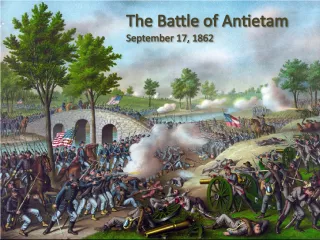




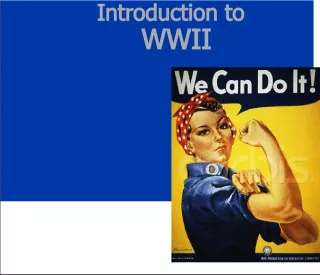

![Exploring [Topic]: Answers, Facts, Opinions, and Resources](/thumb/20000800/exploring-topic-answers-facts-opinions-and-resources.jpg)




